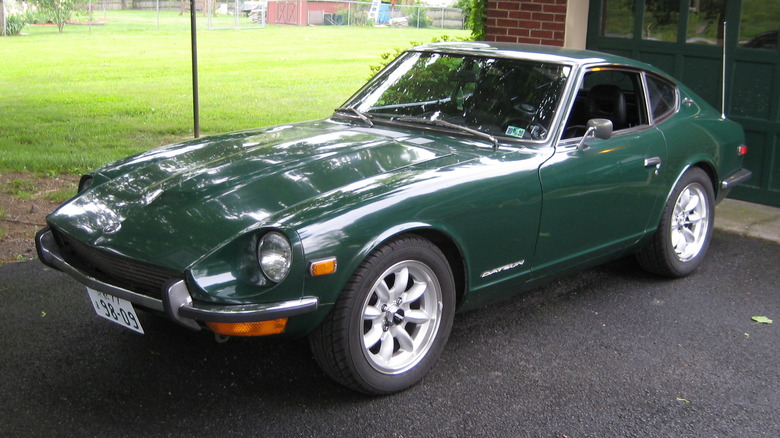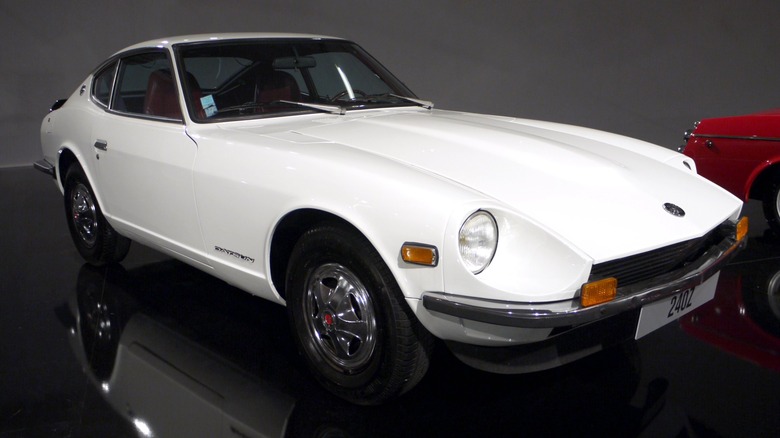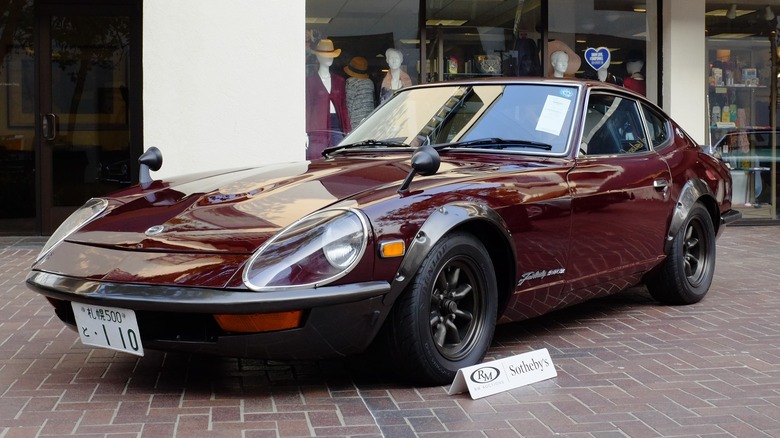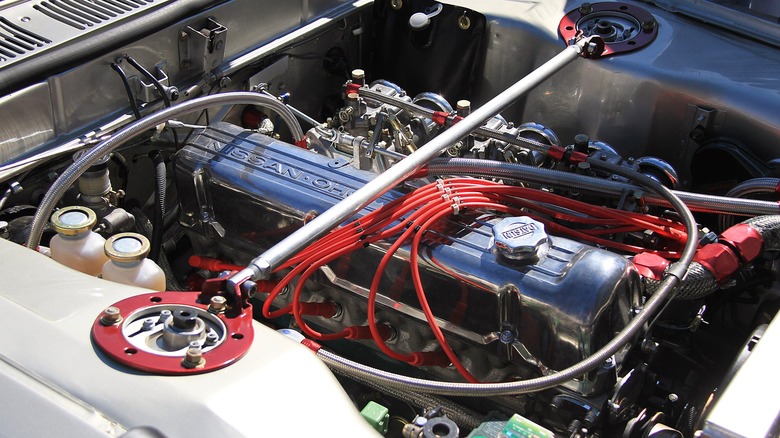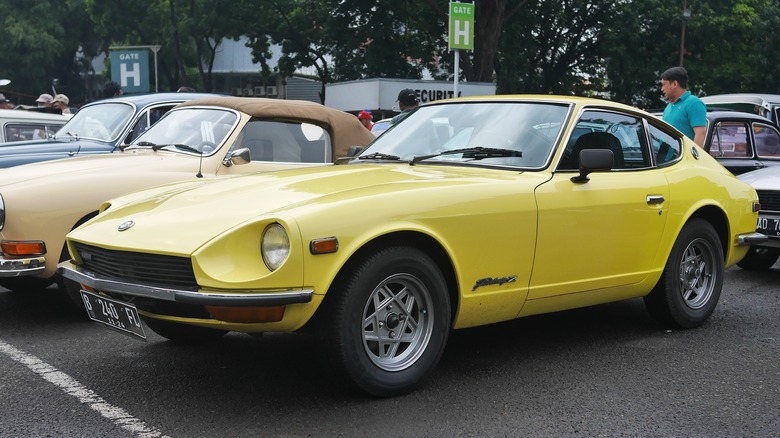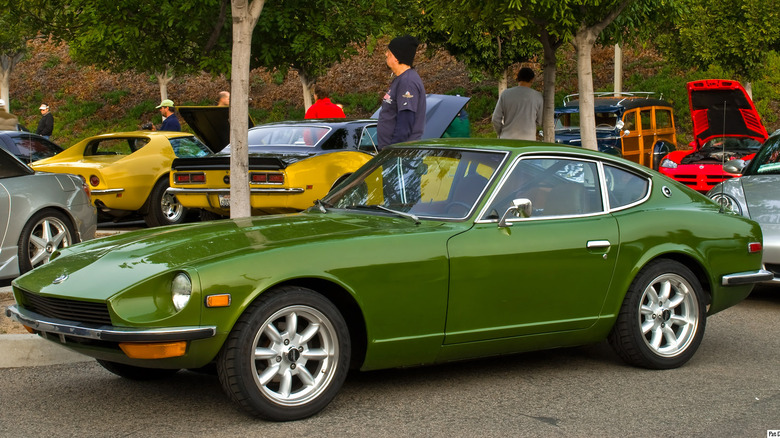5 Things To Know Before Buying A Classic Datsun 240Z
The classic Nissan S30, sold in America as the Datsun 240Z, is one of the best-looking cars to come out of Japan during its time. Its shape with a long hood and a swept-back fastback greenhouse appears to draw inspiration from period Jaguars and Ferraris, but its designer says he was actually inspired by an ad for a Parker pen.
Launched in the United States in 1969, the 240Z remained on sale until 1973, when it was replaced by the Datsun 260Z. But even though it came from an automaker with relatively little experience making sports cars (aside from its work on the Datsun Fairlady 1600, AKA Datsun Sports), it was a remarkable technical achievement.
It featured a very smooth straight-six that not only was surprisingly refined for the era but also bestowed the 240Z with very competitive performance — it was no V8, but it felt quick enough. And even though Nissan hadn't made many sports cars before, it got this one just right, with its blend of design, power, good handling (even by modern standards), and stability at speed. It was considered very accomplished by period motoring journalists.
Today, these first-generation Z cars are seen as classics, so they can be expensive, especially if you're looking at a special edition model, but you can still find some good deals if you're willing to put up with some faults that you can fix along the line. By the standard of the early 1970s sports cars, the 240Z was very reliable, and if it's well looked after, mechanical issues shouldn't be too common.
Rust is a 240Z's worst enemy
Nissan built over 160,000 240Zs for the American market, so it's not a rare car, but the number is surely going down because these cars have a reputation for rusting. 240Z enthusiasts who know these cars well will say there is no such thing as a 240Z without rust; it's even present on the ones that look pristine, but it hasn't yet been discovered.
One of the most common points for rust to appear is the underside of the car. Rust will eat its way through the floorpan and eventually turn the 240Z into a Fred Flintstone car. Cutting out what's left of the floor and welding in a brand new one is not unheard of among 240Z restorers.
The person trying to sell you their 240Z as rot-free might not even be aware that their car has rust because many panels can rust from behind, so you will only start to see it as it reaches the other side. If the paint is bubbling on a 240Z, it's probably rust, and there could be a lot more than you were expecting. You should also check if the car has rust around any of the suspension mounting points. If it's present, it can have severe consequences for handling, and repairs in these areas are difficult.
Badly-repaired accident-damaged cars are also more prone to developing rust, especially if the shop that did the repairs cut corners. Keep in mind that for a couple of decades after it went out of production, this was seen as just an old car, not a classic, and many were left outside unprotected for years, which exacerbated the widespread rust problem.
Buying a modified 240Z may be unwise
240Zs were so plentiful and affordable that many were taken racing, and they were heavily modified, with roll cages, chassis reinforcement panels, and even body kits. However, there are also those owners who wanted to achieve a certain exterior style with their 240Z, so they may have bolted on various "go-faster" accessories that could have affected the car's body.
They may have drilled holes to attach various aerodynamic aids or rolled the fenders to fit wider wheels, and some of these mods can be quite tricky to reverse. Some will require a lot of work to bring the car back to its original form, so it's best to get one as close to stock as possible. You can modify it yourself afterward, but it can be a real pain to undo someone else's modifications that you don't want on the car.
If some of the interior panels are missing or have been replaced with non-original parts, it could prove tricky (and expensive) to source good replacements. Some owners who took their 240Z to the track may have completely stripped out the interior and replaced the seats, and if they are not offered with the car, it may not be wise to buy one, thinking you're going to source everything individually later.
The original hubcaps with the D logo are also very hard to come by, but they are essential if you're looking for a stock-looking example.
The L24 engine was great
The 2.4-liter inline-six L24 engine is a big part of why the 240Z was so popular. It makes 150 horsepower at 5,600 rpm, but you can rev it past 6,000 rpm to really hear it sing. Torque was not very high, just 146 pound-feet (198 Nm), but it's enough to make the 2,400-pound 240Z feel spritely even at lower revs.
The car could hit 60 mph in around eight seconds and had a more than respectable top speed for its day of 125 mph (201 km/h). This made its performance comparable to that of many European sports cars of its day, and even today, more than adequate to get up to highway speeds and even have a little bit of fun on a winding road.
But if that's not enough power for you, then you can modify the L24 to get it to produce more power. The first thing you could do is replace the two factory carburetors with an aftermarket trio of higher-flow carbs, and that should give the car considerably more oomph at the top end, giving you more reason to rev it all the way to the 7,000 rpm redline. This is a relatively simple operation to do, but you will need to find a specialist to help tune your new carbs, as this is an essential step in getting the most out of them.
In stock form, the L24 is surprisingly quiet, so you could pair your properly tuned carbs with a freer-flowing exhaust to also make it sound like it has some extra power.
Its handling is surprisingly good
One common theme that shines through many Datsun 240Z reviews is just how good the car's handling was. The car had fully independent front and rear suspension, as well as disk brakes up front, and thanks to its rigid unibody construction, it feels precise and controlled through the bends.
The suspension is definitely soft by modern standards, but once you get used to how the car leans from one side to the other down a canyon road, it inspires confidence. It still leans considerably less than some American cars of the era, and its very little weight helps it feel agile and responsive.
Given the 240Z's age, there are no driver aids to speak of, but you can make the car safer by upgrading its suspension, brakes, and wheel and tire combo. These are all reversible mods that don't significantly affect the car's originality, but by making it stiffer and giving it better brakes with stickier tires, the 240Z becomes a true driver's car that would enthrall any enthusiast.
It's a great choice for a classic daily driver
Owning a classic car and running it daily may not be advisable if the car in question is slow, difficult to drive, or prone to breaking down and leaving you stranded. But the 240Z is none of those things, and even in stock form, it is more than capable of meeting your daily transport needs.
It felt modern for its time, but today, it feels like an old car, so it's not going to be as comfortable, safe, efficient, or reliable as a modern equivalent. But it's an excellent pick if you want to experience daily classic motoring. It even came with a three-speed automatic gearbox, which is perfectly suited for the role of relaxed cruiser.
The only slight drawback is the fuel consumption, which is high by modern standards. The larger fuel-injected L28 2.8-liter engine from the later 280Z is a common swap among 240Z owners who want better drivability and efficiency.
Another common swap that makes the 240Z a better daily is a five-speed manual transmission from a later model. Having a fifth gear helps make the car quieter and more efficient at higher speeds, so if your commute has a lot of highway miles, this may be a modification for you to look into.
